The Carens has been updated with a new look, more features, and a suffix. Can the Clavis take forward what the Carens started?
Kia has revamped the Carens for 2025, and instead of calling the model a facelift, it has given it a whole new suffix called ‘Clavis’. Because Kia wants to position the Clavis higher than the Carens, and the Carens, in its current iteration, will continue to be on sale, albeit in a lower trim. But with a revamped design, extra features and even a manual gearbox for the turbo-petrol engine, can the Clavis take the legacy forward?
Kia Carens Clavis exterior design and engineering – 8/10
Refreshed looks and larger 17-inch alloys
Like the Carens, the Clavis, too, sits on the K2 platform, and there aren’t any major changes to the dimensions. The marginal increase in length is due to the reprofiled bumpers that are now sharper and monolithic. The upright design for the face has also resulted in a slightly raised bonnet, but the overall silhouette remains recognisable. The front features a faux-metal trim designed to look like a bash plate and add a touch of ruggedness, but the most recognisable change is the new LED headlamps. The casing is all new, and the sharp daytime running lamps stretch across the bonnet and bumper. The headlamps are stacked in an ice-cube style, like on the Syros.
New triangular headlamps are the most recognisable update; front bumper has a monolithic look.
Over to the side, the alloy wheels are now larger 17-inch units with a sharp dual-tone look, and that’s what helps the MPV look more proportionate now. Like the front bash plate, there is a faux metal panel along the doors, and the cladding tries to give it an SUV look.
The rear features subtle changes, like a stop lamp integrated into the spoiler and new inserts for the tail-lamps with a thicker LED bar connecting the two ends. Some more brushed metal inserts add bling, and the Carens badge now has the Clavis suffix. Overall, the design has freshened the look, and a new ‘Ivory Silver Gloss’ paint shade has added some premium appeal.
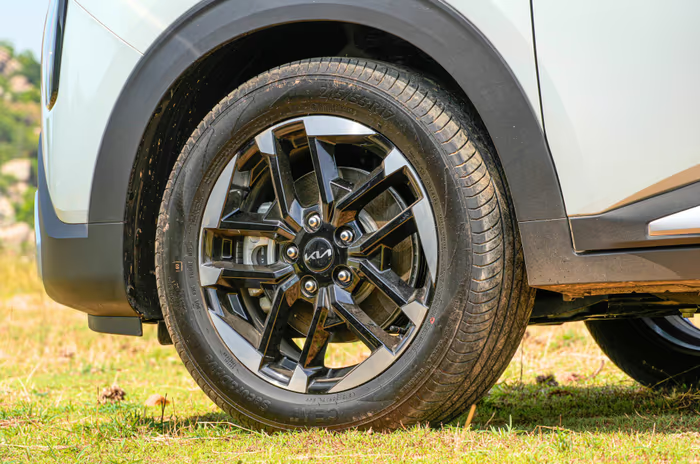
Larger 17-inch wheels get a dual-tone finish.
Kia Carens Clavis interior space and comfort – 8/10
New dashboard with more features but same space as before
The dashboard has been revised with a fabric-like panel sandwiched between the beige-and-blue theme. What dominates are the dual 12.3-inch screens set on a single panel, giving it a seamless look.
Low down on the centre console is a revamped HVAC setup, which now features a touch-sensitive panel in the top-spec trims. The panel also serves for media and communication functions, but it isn’t seamless or easy to use. Reflections are an issue, and on the move, you end up accidentally hitting the wrong functions. Physical buttons on lower specs are a lot easier to use. Practicality is good, too, with two cup holders with vents to keep drinks cool, a wireless charging pad and a cubby hole under the front armrest.
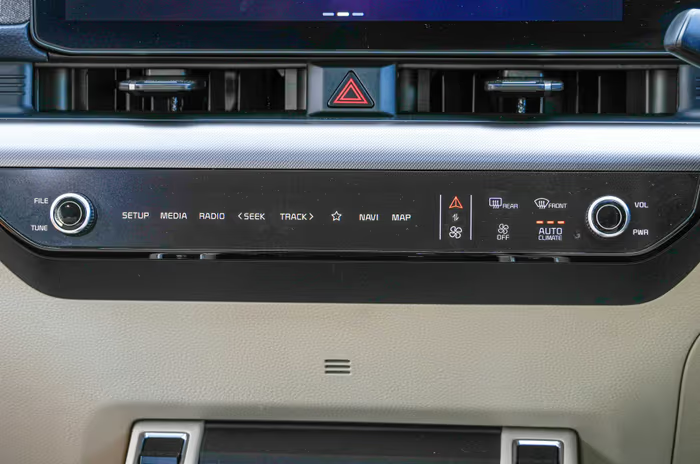
Switchable HVAC panel isn’t seamless or easy to use.
Like before, the front seats are ventilated, but the driver’s seat features power adjust with manual adjust for the height. On the top-spec trim, the leatherette upholstery is beige, while the lower trims get a dark upholstery that is much easier to maintain.
The middle row varies depending on the version chosen: 6-seater or 7-seater. Since the wheelbase has not changed, the space remains the same. There is enough kneeroom and headroom, but the sliding seats allow for even more space. The new change is the dual-pane panoramic sunroof, which opens up the cabin, and yet, there is no compromise on the headroom. The AC vents have been repositioned above the windows and are much more effective. The top-spec version also gets foldable trays and an air purifier. Sun blinds are another plus point, and there is a Boss mode that enables rear passengers to move the front seat ahead to open up more legroom. Ingress and egress are also very impressive since the seat height is comfortable.
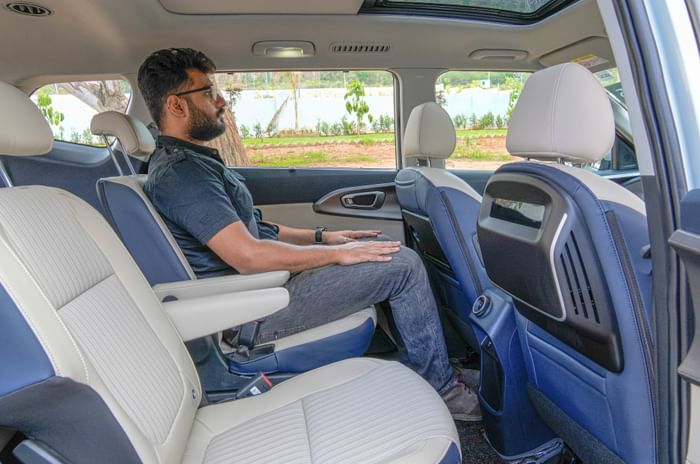
Middle row space remains unchanged from regular Carens; panoramic sunroof allows more light.
Getting into the third row is a bit easier now thanks to a one-touch tumble and fold feature on the left seat. Once inside, there is adequate space for two adults, and since the middle row is adjustable, one can find a comfy spot. There are AC vents and USB ports in the rear, along with adjustable headrests and seatbelts.
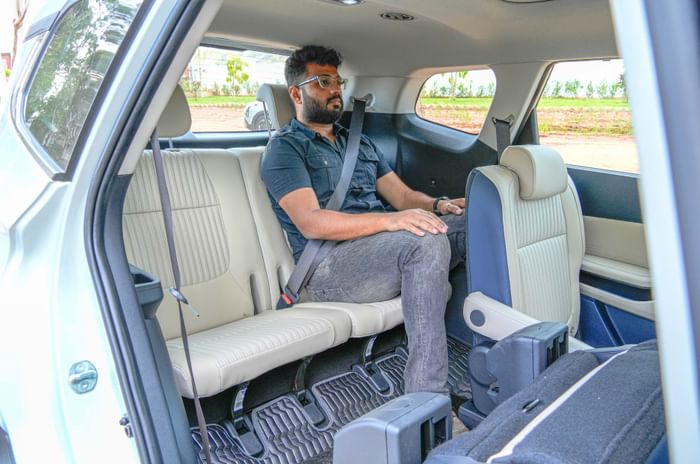
Third row has adequate space for two adults.
With three rows up, the Carens Clavis gets 216 litres of boot space, enough for at least four soft bags. Trolleys and suitcases will be restricted, depending on their shape and size. If there isn’t the need for a third row, you can flat-fold it to open up more space, and there is even a spare wheel under the car, with some space under the boot floor for tools. The Carens Clavis scores well on packaging and practicality, and with the new feature additions, it has only gotten better.
Kia Carens Clavis engines and performance – 7/10
Multiple powertrain options give buyers ample choice
The Carens Clavis features a choice of three engines – a turbocharged petrol, a naturally aspirated petrol and a diesel – and as many as six gearboxes.
We drove the turbo-petrol in manual and DCT guise and the diesel automatic, as the naturally aspirated engine is only available in lower trims with a manual gearbox. The 160hp 1.5-litre turbo-petrol with the 7-speed DCT or the 6-speed iMT is the same one as we saw in the Carens, but in the Clavis, there is also the choice of a 6-speed manual.
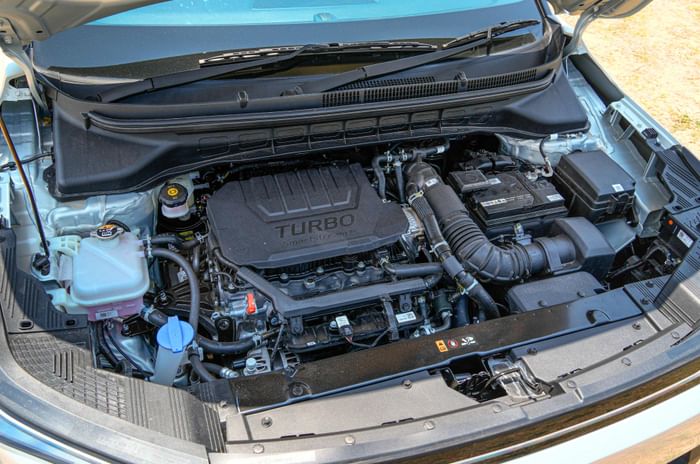
1.5-litre turbo petrol is refined but doesn’t excite with performance.
What’s nice about the engine is its refinement and the fact that it has enough poke in the low rpms. That said, you won’t feel any surge or excitement as the power delivery remains gradual. The engine picks up pace from as low as 1,500rpm, and after 2,000rpm, there is a strong but linear pull. 4,200rpm is where the pull ends, and if you push it to redline, there is only a coarse sound without much progress. It’s safe to say that the best way to use the mill is to keep it in the mid-range. The manual gearbox allows you to eke out the maximum from the engine. The clutch is light and progressive, with a bite point that is not abrupt. The gates, too, are well-defined, offering more driver engagement.
7-speed DCT with turbo-petrol is smooth at cruising speeds but not in the city.
The 7-speed DCT, on the other hand, is smooth only at cruising speeds. In the city, it isn’t as seamless as you’d expect a DCT to be, and there is some hesitance while shuffling between low gears. There are drive modes in the DCT version, and Sport is where the response is most evident. You also have the option of shifting using the paddle shifters, which are rather good, and you can also slot the shifter into manual and use it as a Tiptronic – although it won’t be as satisfactory as the paddles. Drive it sedately, and the DCT will offer progress without any of the left-foot stress.
The 116hp diesel is the old tried-and-tested engine with superb cruising abilities. Sure, it is not responsive or quick, but once it gains highway speeds, it can settle into 6th gear and cruise all day without complaints. Where it struggles is when you want a quick overtake. There simply isn’t enough grunt, and the automatic takes a while before downshifting and lending a helping hand. This will stick out like a sore thumb on an uphill section with a car loaded with passengers and luggage. Also, the Clavis has a front-wheel drive, so steep uphill slopes require more effort, and here is where the diesel mill yearns for more power.
The tried-and-tested 1.5-litre diesel can cruise all day with no complaints.
Refinement is another area where the diesel falls back, especially under acceleration. There is a coarse diesel drone, and the lack of drive modes means there is no way to alter the performance. What it will do very well, though, is maintain a 15-16kpl efficiency (MID displayed), so for those who end up racking up the kilometres, the diesel can be a better option.
Kia Carens Clavis ride and handling – 7/10
Smaller 16-inch wheels on diesel offer better ride than the 17-inch ones on petrol
There has been slight retuning to the suspension for the added weight from the panoramic sunroof, ADAS and the larger 17-inch wheels in the petrol versions. Still, the ride is supple, with only a hint of firmness over low-speed bumps. The Clavis feels planted at high speeds, and only when you show it some corners does the body roll rob away some stability.
The Clavis has a supple ride and a planted feel.
The diesel is better here since the smaller 16-inch alloys get a larger tyre profile that helps absorb the bumps. At the same time, the smaller section means body roll is even more pronounced, and you need to be relaxed around bends. We did not get a chance to test it with a full load, but it is safe to say that with relaxed driving manners, the Clavis is surefooted on the road.
Kia Carens Clavis features and safety – 9/10
Lots of new additions over the regular Carens
The dual 12.3-inch screens run the UX/UI from the Seltos, which is clean and smooth. Screen responsiveness is good, with no lag. However, wireless Apple CarPlay and Android Auto are sorely missed. Notably, the lower-spec versions with the smaller 8-inch unit get wireless connectivity. A 360-degree camera is a new addition, and it has good resolution with no lag.
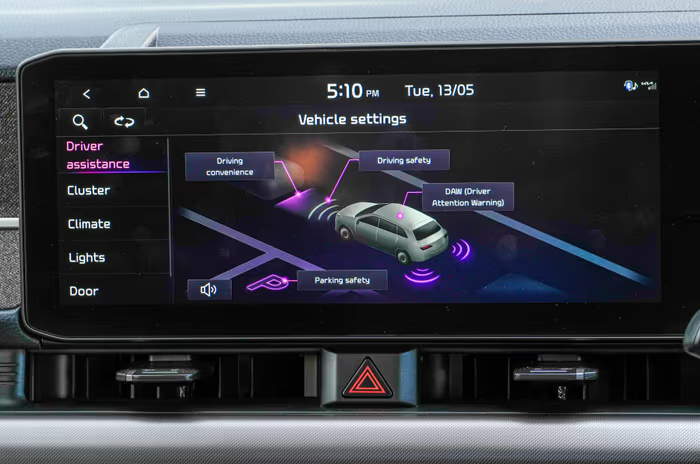
New ADAS features function well in our erratic traffic conditions.
Similarly, the 12.3-inch digital cluster is crisp and can change themes depending on the drive mode. For safety, there is also level 2 ADAS, which, thankfully, can be switched off manually. When left switched on, it functions well, and the good part is that there is a reasonable buffer for our erratic traffic conditions. Blind-spot monitoring, lane-keep assist and rear cross-traffic alert are especially useful. The Clavis also features a new steering wheel, like the one in the Syros. The shape might take some time to get used to, but it does get tilt and telescopic adjustment.
Kia Carens Clavis price and verdict – 7/10
Multiple variants and overlap might confuse buyers; expect a significant bump over the Carens
Kia has not yet revealed pricing for the Clavis, but with the added features, you can expect an increase of Rs 50,000 to Rs 1.2 lakh, depending on the variant. Also, the Carens, as we know it, will continue to be on sale, albeit in only one trim and one engine option, which we assume will be for the fleet operators.
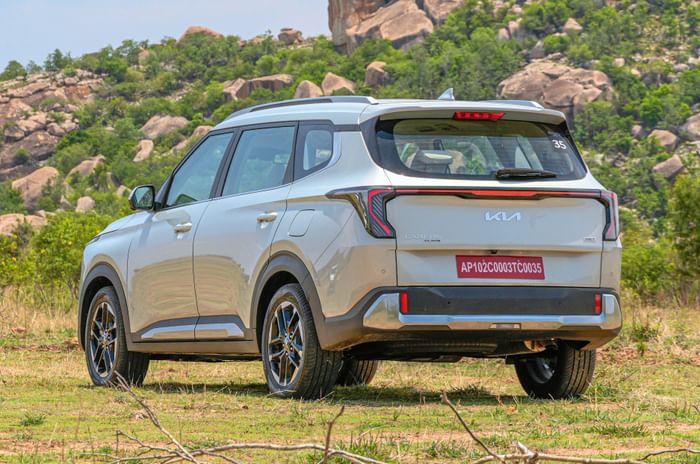
The Clavis makes for a sensible package with a good dose of desirability.
To sum it up, the Clavis is a good update to the Carens since it has added some much-needed features and modernity while retaining the strong points like multiple powertrain options and practicality. It is a sensible package with a good dose of desirability sprinkled on, and all that’s left now is for Kia to price it disruptively. We expect the top-spec turbo-petrol with the DCT and all the bells and whistles to touch Rs 21 lakh. But crucially, the pricing for the mid variants will be of interest to the masses. They’ve done the tough bit well, and it’s only the numbers that they need to ace. And given Kia’s history, that shouldn’t be a point to worry about.
Also See:
Kia Carens Clavis video review
